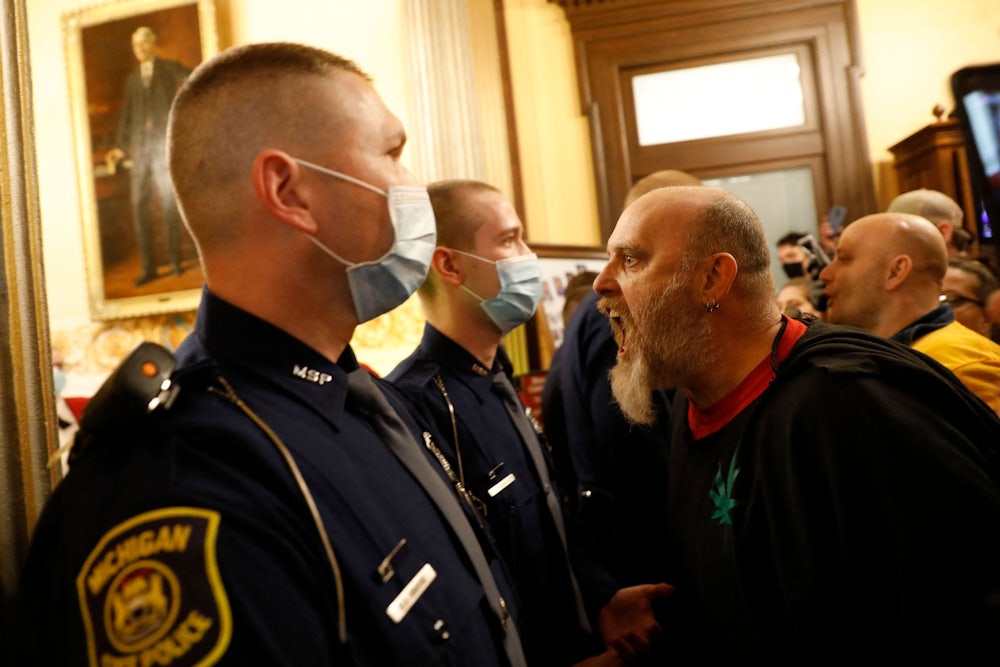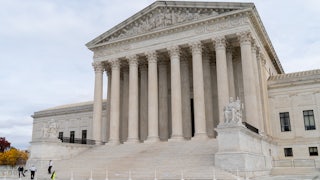On the morning of March 12, 2020, I sat in a legislative committee room in Lansing, Michigan, waiting for my colleagues to show up. I pulled my phone open to scroll through news headlines when one in particular caught my eye. I rolled my chair back and turned to Molly, my chief of staff, sitting directly behind me.
“Look at this.” I pointed to the headline.
“That can’t be real,” Molly gasped. “Is it real?”
“Looks like the movie Contagion,” I said as I wheeled back to the committee table.
I’d just read that the state of New York had declared a state of emergency due to the Covid-19 virus, and had set up a containment zone around New Rochelle. The photo accompanying the headline featured National Guard members and nurses in hazmat suits. In New York, every public space—schools, houses of worship, grocery stores—emptied, some practically abandoned. But in Michigan it was a normal day, with people packed into a crowded committee room, members straggling in as usual. For the life of me, I can’t even remember the bill we were hearing or even the topic at hand, but I sure remember that headline and the surreal sensation of reading it.
By April 30, less than two months later, everything had changed. Heavily armed protesters and militias had stormed the Michigan state Capitol. The yelling, banging, and chaos echoed through the rotunda and rattled the doors of the 144-year-old building. Outside the Capitol, people carried signs protesting the Covid-19 lockdown. But more prevalent were the nooses, swastikas, Confederate flags, and the men in head-to-toe tactical gear, heavily armed with handguns and rifles: the Oath Keepers, the Three Percenters, Boogaloo Bois, and more. A photo of four such heavily armed men lurking up in the Senate gallery went viral. It was taken by my seatmate, state Senator Dayna Polehanki. What you didn’t see in that photo was us, below the gunmen, trying to go on about the business of the state. Looking back, I don’t know why I stayed on the Senate floor.
More than two and a half years from those terrifying moments, our state and our country are still torn apart, and the divisions keep growing deeper. Americans seem to live in a pair of disparate and increasingly incompatible realities: one hoping to uphold our democracy, flawed though it may be, and another driven by conspiracy theories, increasing distrust in elections and the media, and the ego of Donald Trump. The rift in our society has allowed conspiracies, hatred, violence, and lies to flourish.
Given all this, what will our country look like in 2050? Will our democracy survive? Well, just a few years ago, I was exactly the type of person who would dive into these types of questions primarily as a creative exercise. I’ve been a car designer, a creative director, a writer. I’d built a body of work by imagining new realities and working to bring them to life.
But now? How to preserve democracy is no longer an interesting thought experiment; rather, it’s an existential question I face every single day as a sitting state senator heading into my second term in one of the country’s most consequential (and chaotic) battleground states.
The past few years have revealed just how fragile our democracy—our laws, rules, and norms—really is. It’s also revealed that far too many of us have been complacent, expecting that our Founders’ framework would, indeed, correct itself. We believed in guardrails that would hold the essential values of our democracy in place, that our freedoms would always be protected, that our rights would remain. We believed that our votes, our voices, would always count. Far too many of us were wrong.
As a lawmaker myself, I’m in a position to craft bills and pass legislation. But when lawmakers and everyday Americans alike neglect to actively uphold our Constitution and our nation’s framework, then laws—and the ideas upon which they are built—lose their power and meaning; they’re just words. Words that can be ignored, abused, manipulated, and torn down by those seeking their own gain—if we allow it to happen.
So here’s my prediction: The United States of America will survive; so will its democracy. I believe that by 2050, we will have legislatures, on both the national and local levels, that are more representative of their constituents than those we have today. We will still argue. We will still debate. But it will be about tax policy, not about whether you have the right to vote, or whether women deserve autonomy over their own bodies, or whether people should be able to love who they love. And I hope that we’ll reflect on this era as one in which our country was pushed to the brink, but endured.
But there’s a caveat. This prediction depends on you. To preserve our democracy, each American must participate in it—yes, by voting, but also by taking a much more active civic role, too. Get involved with a local city council, school board, or state legislative race. Volunteer. And donate to the people fighting down-ballot who are too often overlooked and ignored, but who are on the front lines of protecting democracy in the states.
While we look ahead with hope to the new year, we realize that many of the horrors of 2020 remain with us. So maybe we approach our resolutions a little differently for 2023: Let’s resolve to not just look inward, but outward, and aim to be better Americans, to embrace the work of democracy, so that by 2050, we’ll proudly stand together as the truly United States of America.






